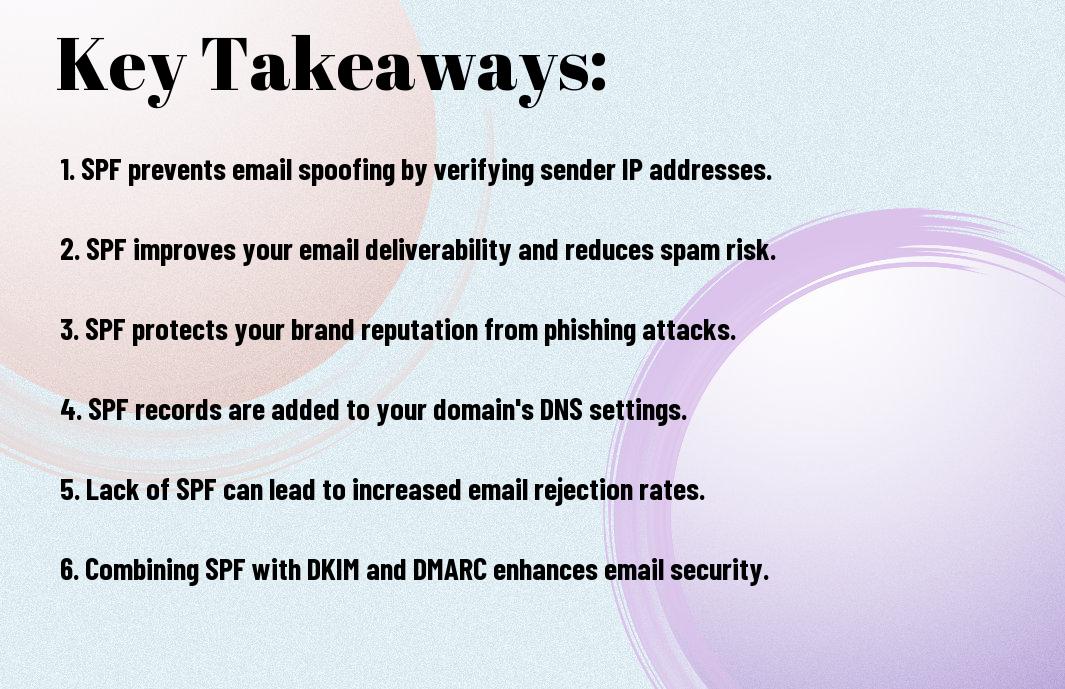You may not realize it, but email security is vital for your business’s reputation and communication. Sender Policy Framework (SPF) is a key mechanism that helps protect your email domain from being spoofed by malicious actors. By defining which mail servers are allowed to send email on behalf of your domain, SPF enhances your email deliverability and safeguards your brand. In this post, we’ll explore what SPF is and why implementing it can significantly benefit your business communication strategy.
Key Takeaways:
- SPF (Sender Policy Framework) helps validate that emails sent from your domain are authorized, reducing the risk of email spoofing.
- Implementing SPF can improve your email deliverability, ensuring that your messages reach their intended recipients instead of being marked as spam.
- SPF records are added to your domain’s DNS settings, specifying which mail servers are allowed to send emails on behalf of your domain.
- SPF provides a layer of security for your business communications, protecting both your brand reputation and your customers from phishing attacks.
- Regularly reviewing and updating your SPF records is important to accommodate any changes in your email infrastructure or third-party services.
The Critical Role of SPF in Email Security
SPF plays a fundamental role in enhancing your email security by verifying the legitimacy of the sender’s address. By establishing a clear policy for which mail servers can send emails on behalf of your domain, SPF reduces the likelihood of your messages being intercepted or misrepresented. This verification process not only protects your brand from phishing attacks but also maintains trust with your customers and partners, ensuring that your communications remain secure and credible.
How SPF Works: The Mechanics Behind Sender Verification
SPF operates through DNS records by allowing domain owners to publish a list of authorized sending IP addresses. When an email is sent, the recipient’s server queries the DNS records to confirm whether the server is listed as an authorized sender for the domain. If the sender’s IP address matches an entry in the SPF record, the email passes verification. Otherwise, it may be flagged as spam or rejected entirely, thereby preventing unauthorized use of your domain.
The Evolution of Email Threats: Why SPF Became Essential
Email threats have significantly evolved, leading to increasingly sophisticated strategies used by cybercriminals. Phishing attacks, where attackers impersonate trusted entities to steal sensitive information, have risen sharply. The Anti-Phishing Working Group reported an increase of nearly 30% in phishing attacks between 2019 and 2020 alone. As these threats have become more prevalent, SPF has become an important tool to detect and prevent email spoofing, protecting both your business’s identity and your customers from fraudulent communications.
The rapid rise in email fraud has prompted businesses to reassess their security measures. In the past, rudimentary spam filters were often adequate, but as threats advanced, they became inadequate against sophisticated spoofing techniques. With SPF, you establish a proactive defense against such attacks by providing authenticating checks that help determine whether an email is genuinely from you or an impersonator. As a result, incorporating SPF into your email practices not only fortifies your security posture but also builds a layer of trust with your audience in an era fraught with malicious activities.


The Business Implications of Not Implementing SPF
Neglecting to implement SPF can lead to a cascade of setbacks for your business. Phishing attacks often target companies without robust email authentication, leading to significant financial losses and client distrust. As cybercriminals spoof your domain, they can exploit your workforce or clients, resulting in stolen credentials and potential data breaches. Moreover, the time and resources your team must allocate to rectifying these issues can divert attention from core business initiatives, ultimately stunting growth and harming your competitive advantage.
Exploring the Financial Risks of Phishing Attacks
Phishing attacks can impose severe financial damage on your business. The average cost of a successful phishing attack can easily exceed $3.8 million, factoring in lost revenue, data recovery, and potential legal fees. When employees unknowingly provide sensitive information, the consequences extend far beyond immediate monetary losses, impacting long-term profitability and operational stability as expenditures rise in response to the incident.
Impact on Brand Reputation: A Case of Mistrust
Brand reputation suffers significantly when a phishing attack is linked to your company. Trust is integral to customer relationships; when clients perceive that your business may compromise their personal information, they are likely to sever ties. A single incident can taint your reputation, causing a long-lasting decline in customer loyalty and engagement. Companies like Sony and Target experienced steep drops in user trust following high-profile security breaches, demonstrating how swiftly a brand can deteriorate in the eyes of its customers.
Once your reputation is tarnished, the path to recovery can be challenging. Customers may voice their concerns on social media, leading to public relations nightmares that ripple through your brand’s image. The financial implications of regaining trust may require substantial investments in marketing and security enhancement. Realigning your brand’s message, coupled with assurances of improved cybersecurity measures, can take years to restore customer confidence, all while your competitors capitalize on your misfortune.
Setting Up SPF: A Step-by-Step Guide
Identifying Your Email Sources: Domain Whitelisting |
Begin by compiling a list of all domain names that send emails on behalf of your organization. This includes your company’s own domain, along with any third-party services you utilize for marketing, newsletters, or transactional emails. Visualize this step as setting up a trusted network, ensuring that only verified senders can reach your audience. |
Crafting Your SPF Record: Syntax and Requirements |
Your SPF record must follow a specific syntax to function correctly. It begins with “v=spf1,” followed by the mechanisms that outline the permitted sending servers for your domain. Each mechanism tells recipients whether the sending server is authorized to send emails, using terms like “ip4,” “ip6,” or specific domain names to denote valid sources. |
To create an effective SPF record, you will use various mechanisms that determine whether an email originates from an authorized source. For instance, if you have an IP address from which you send emails, you would include it using the “ip4” or “ip6” mechanism, depending on the IP version. Additionally, you can incorporate third-party services with the “include” directive, such as “include:example.com,” allowing their servers to send on your behalf. Ultimately, an SPF record concludes with an “all” mechanism that specifies the action to take if none of the previous rules match, commonly set to “~all” for soft fail or “-all” for hard fail. This precise structure ensures your emails have a higher chance of reaching their intended recipients without being flagged as spam.

Beyond SPF: Enhancing Email Security Further
Implementing SPF is only the first step in securing your email communications. To further enhance protection, you should also adopt DKIM (DomainKeys Identified Mail) and DMARC (Domain-based Message Authentication, Reporting & Conformance). These additional protocols work in tandem with SPF to strengthen your email authentication, helping to combat phishing and other malicious activities targeting your business.
Unlocking the Power of DKIM and DMARC
DKIM adds a digital signature to your email messages, verifying their authenticity and integrity as they travel across the internet. DMARC builds on SPF and DKIM by providing guidelines for email receiving servers about how to handle messages that fail authentication. Together, these tools ensure that only legitimate emails from your domain reach your recipients, thereby reducing the risk of fraud.
Creating a Multi-Layered Security Strategy
To bolster your email security, develop a multi-layered strategy that incorporates SPF, DKIM, and DMARC. This approach not only fortifies defenses against unauthorized access but also enhances your reputation with potential clients and partners. Regular monitoring and updates to these protocols ensure you adapt to evolving threats, fostering trust in your email communications.
A multi-layered security strategy goes beyond mere implementation; it involves continuous assessment and adaptation of your email security measures. Schedule routine audits of your SPF and DKIM settings, utilizing tools that provide real-time feedback on email authentication. Additionally, educate your employees about phishing tactics and the importance of maintaining robust passwords. By investing in training and regular updates, you enhance your business’s overall email security posture, safeguarding both your brand and clientele.
Real-world Success: Companies That Fortified Their Email Security
Many organizations have successfully enhanced their email security by implementing SPF, seeing significant boosts in their email deliverability and lowering instances of phishing attacks. Notable successes include large enterprises like PayPal, which tightened their security protocols and reported a 99% increase in valid email authentication. These companies demonstrate that robust email security measures not only protect their brand reputation but also build trust with their customers.
Case Analysis: How One Enterprise Increased Deliverability
After a global retail company enforced SPF, their email deliverability jumped by 30%. By aligning their sending domains with SPF records, they minimized spam filtering, which had previously hindered their communication with customers. This change led to increased engagement as newsletters and promotional emails had higher visibility in inboxes, ultimately driving sales and customer loyalty.
Lessons Learned: Best Practices for Continuous Improvement
Continuous improvement in email security involves regular audits of your SPF records and vigilant monitoring of incoming inbox metrics. Innovative companies often recalibrate their SPF configurations to adapt to changing sending sources or marketing strategies. Moreover, as you analyze delivery rates and open rates, seeking feedback and iterating on your approach can further enhance your email security and effectiveness.
To build a resilient email security framework, integrate regular training for your team on phishing awareness and email authentication best practices. Keeping everyone informed about the latest threats helps maintain a culture of vigilance. Regularly review your SPF records to ensure they accurately reflect all authorized sending sources. Embracing tools for monitoring email deliverability offers insights that guide your strategy, making it easier for you to stay adaptive and proactive in your email security measures.
Conclusion
To wrap up, implementing SPF for your business email is crucial for establishing trust and enhancing security. This protocol helps prevent email spoofing, ensuring that your communications remain authentic and reliable. By taking the time to configure your SPF records correctly, you protect not only your reputation but also your customers. For more insights, check out Understanding SPF Records: Enhancing Email Security – Bird.
FAQ
Q: What is SPF in the context of email?
A: SPF, or Sender Policy Framework, is an email authentication protocol that helps verify the identity of the sender. It allows domain owners to specify which mail servers are authorized to send emails on behalf of their domain. By doing this, SPF helps prevent email spoofing, which is when someone forges the sender’s address, making it appear as if the email is coming from a legitimate source.
Q: How does SPF work?
A: SPF works by using DNS (Domain Name System) records. When an email is sent, the receiving mail server checks the SPF record of the sender’s domain to see if the IP address of the sending server matches one of the addresses listed in the SPF record. If there is a match, the email is considered valid; if not, it may be rejected or marked as spam, depending on the receiving server’s policies.
Q: Why is SPF important for business email security?
A: Implementing SPF is vital for business email security because it helps protect against unauthorized use of your domain. By reducing the chances of email spoofing, SPF bolsters the integrity of your email communications, enhances your brand’s reputation, and decreases the likelihood of phishing attacks targeting your customers or employees. This, in turn, can improve email deliverability and increase trust in your business communications.
Q: What happens if my business does not use SPF?
A: If your business does not implement SPF, your emails may be more susceptible to spoofing and phishing attacks, leading to potential damage to your reputation. Additionally, emails sent from your domain might have a higher chance of being flagged as spam by receiving mail servers, which can result in decreased email deliverability and reduced communication effectiveness with clients and partners.
Q: How can I set up SPF for my business email?
A: To set up SPF for your business email, you need to create an SPF record in the DNS settings of your domain. This record will include IP addresses or domains of the servers authorized to send emails on behalf of your domain. There are several online tools and SPF record generators available that can help simplify this process. After creating the SPF record, it’s crucial to test its configuration to ensure it’s functioning correctly, and make adjustments as necessary.

